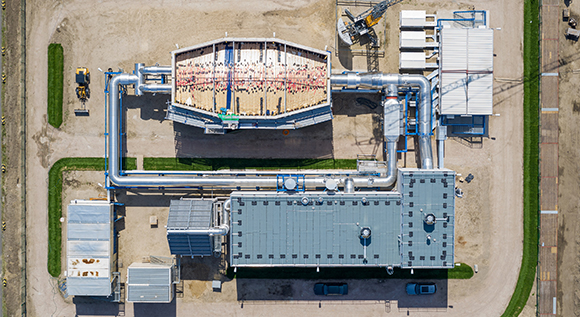Volcanic rock stores wind energy
Researchers in Hamburg have developed a heat storage facility which can already supply some 3,000 households for one day with electricity generated from wind power – and this is just the beginning. The secret: volcanic rock from the depths of the Earth.
 © Copyright: Siemens Gamesa Renewable Energy / Ulrich Wirrwa
© Copyright: Siemens Gamesa Renewable Energy / Ulrich Wirrwa
"Welcome to the new stone age" say the large letters on the sign at the world’s first electro-thermal energy storage facility. It uses a very special technology and came on stream in Hamburg in June. The concrete building is 22 metres long, 11 metres wide and 11 metres high - roughly the size of an Olympic swimming pool - and is located on the site of the Hamburg-Altenwerder aluminium smelter in the port of Hamburg. It is filled with close to a thousand tonnes of volcanic rock. The idea is that if the wind in and around Hamburg is so strong that the electricity grid cannot transport all the wind power generated, the lava rocks will absorb the energy from the surrounding wind turbines and give it back to the grid when it is needed. When they are fully charged, the rocks can store enough energy to cover one day’s electricity needs of up to 3,000 households.
The electro-thermal energy storage (ETES) facility is being run for research purposes by Siemens Gamesa, a wind turbine manufacturer, together with the energy utility Hamburg Energie and Hamburg University of Technology. In future, the partners want to make more use of renewable electricity from wind turbines by decoupling electricity generation from electricity consumption. To this end, they are combining technologies from the fields of heat storage and thermal power plants in an innovative manner. The project is entitled "Future Energy Solution – FES" and is receiving funding of approximately €10.7 million from the Federal Ministry for Economic Affairs and Energy.
Lava instead of coal
With the help of resistive heating and a fan, the electrical energy can be converted into a hot air stream and thus into thermal energy. The hot air is then fed into the insulated concrete structure, which is filled with lava rocks. Something rather like a very hot hairdryer is used to heat the rocks to up to 800°C. After around 24 hours, the rocks are "charged" and can store up to 130 megawatt-hours of thermal energy over a period of a week or more. The ability of the lava to store heat for a long time is not the only advantage. The rock is also comparatively cheap and readily available.
When the electricity is eventually needed, ETES uses a turbine to convert the stored heat back into electricity. The principle is similar to that of a conventional thermal power station, the difference being that lava is used in place of fossil fuels like coal or gas. The heat stored in it is used to heat up air and then water in a steam generator until water vapour is produced. Under pressure, the water vapour then drives a turbine, which generates electricity with a capacity of 1.5 megawatts. If the storage facility is fully charged, the turbine can generate electricity for 24 hours. In the current trial version, ETES produces about 30 megawatt hours. That is enough to supply an average of 3,000 households with electricity for one day or to charge up around 750 electric vehicles.
Zero-emission electricity
The net efficiency of the trial ETES facility in Hamburg currently stands at roughly 22%. To put this figure into perspective: a conventional coal-fired power plant has an average efficiency of 30-40% - but across its entire life-cycle, it releases up to 1,230 grams of global-warming carbon dioxide per kilowatt of electricity. In contrast, the electro-thermal storage facility would be virtually emission-free when used in combination with wind turbines.
The facility in Hamburg is just the beginning for Siemens Gamesa. "The facility in Hamburg-Altenwerder is only a relatively small-scale demonstration and test facility," says Hasan Oezdem, Head of Research and Development and Director of the energy storage programme at Siemens Gamesa Renewable Energy. "The collaborative project aims to show how the storage facility behaves within the overall facility and how it can best be operated in line with the electricity prices." The facility can be scaled up to several gigawatt-hours if there is demand for this. All that is required is some more lava, a bit more space and a larger turbine. Once it is ready for market, the ETES technology is to achieve efficiency rates of up to 45%.
However, this efficiency rating is only one of many factors to be considered when considering how viable the storage facility is. It is also necessary to consider costs for purchase, operation, repair and safety, as well as life-time, cycle stability and environmental aspects. The volcanic rock storage technology is thus competing with other storage technologies, flexible generation and flexible demand.
Will power stations become storage facilities?
Coal-fired power stations closed down in the course of the energy transition could be converted into low-emission long-term storage facilities if components like grid connections, turbines and generators can remain in use. Whether the conversion is technically feasible and makes economic sense in any given case still requires further investigation.

